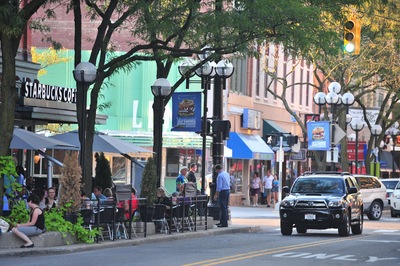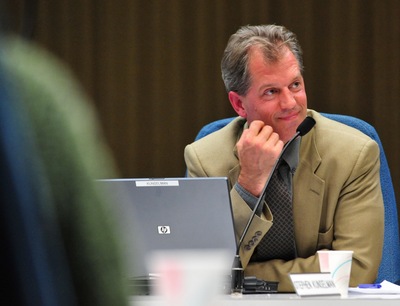Supporters of the Ann Arbor Downtown Development Authority are circling the wagons in advance of tonight's City Council meeting where major changes to the DDA are being considered.
The Ann Arbor/Ypsilanti Regional Chamber joined six other groups in sending a joint letter to the City Council, urging council members to vote against placing new restrictions on the DDA.
"We believe the DDA has done and continues to do good and important work for Ann Arbor's downtown, benefitting all of Ann Arbor," the letter states.
Clik here to view.

Downtown Ann Arbor's Main Street as it looked on a summer night last year. Ann Arbor Downtown Development Authority officials argue the success of the DDA is visible in the success of the downtown, which they consider the best in the state.
Ryan J. Stanton | AnnArbor.com
Mike Henry, chairman of the local Arts Alliance board of directors, sent a separate letter to the mayor and council, also lobbying against passage of the ordinance changes. Henry said the rush to impose new restrictions on the DDA seems ill-considered and comes across as punitive.
"We believe that the Ann Arbor DDA should be applauded for its work, not burdened with rushed, poorly considered funding cuts," Henry wrote.
Council Members Stephen Kunselman, D-3rd Ward, and Sumi Kailasapathy, D-1st Ward, are co-sponsoring changes that would place new limits on the DDA and slow its revenue growth, taking nearly $1 million in tax revenues away next year alone.
The changes also would impose term limits on DDA board members so they could serve up to two four-year terms.
The council voted 7-3 to give initial approval to those changes at its last meeting. The council is expected to take final action tonight.
"I'm not surprised there's a lot of support for the DDA," Kunselman said in response to the letters received from the chamber and other business and community leaders.
"I support the DDA as an institution," he said. "I just don't think they should have a $1 million increase in their budget."
The DDA essentially is an arm of the city government tasked with improving the downtown and managing the city's parking system.
The fact that the DDA is seeing higher-than-expected tax revenues from growth in the downtown is a testament to its good work, reads the letter sent to council by business leaders.
"In short, the DDA is working as intended, benefiting the downtown and the community at large, within the authority and guidance set by council in 2003, and we do not believe there is a demonstrated public need to amend the city's DDA ordinance," the letter states.
The DDA weighs in
AnnArbor.com recently obtained 50 pages of emails traded between DDA Director Susan Pollay and council members in response to a Freedom of Information Act request. In one of those emails, Pollay wrote about what she believes the ordinance changes would mean for the DDA.
"For a City Council that set forward 'Economic Development' as one of its chief priorities for 2013, this proposed ordinance amendment seems a strange first project, because it directly works against the council's goal to encourage new jobs, new residents, and a stronger local economy," she wrote in the email to Council Member Chuck Warpehoski, D-5th Ward.
Clik here to view.

Susan Pollay
Ryan J. Stanton | AnnArbor.com
The DDA's budget is large ($24.1 million), she said, but 32 percent goes to debt service obligations, and 48 percent covers costs of running the city's parking system, including a transfer of 17 percent of parking revenues to the city's general fund. Depending on the year and the projects, she said, about 12 percent goes toward capital improvements, including maintenance of parking facilities.
"Most of the remaining amount goes to DDA grants for things like solar demonstration project at Farmers Market, go!passes, free energy audits for all downtown businesses, holiday lights, spring cleanup," she wrote.
"Reducing the DDA's TIF means there is less money available in the DDA budget to support important projects that help us meet our mission to encourage downtown vitality and private reinvestment."
The DDA is partially funded through TIF — or tax-increment financing — revenue, meaning it captures the increase in taxes resulting from new construction and improvements downtown.
Records obtained by AnnArbor.com show the amount of tax revenue the DDA captures from downtown properties has grown substantially over the last three decades.
It started at $127,258 in 1984, grew to $1.2 million by 1987, hovered between $2.3 million and $2.7 million throughout most of the '90s, and reached nearly $3.2 million by 2003, records show.
It was up to $3.7 million by 2012 — a growth of $842,729 or 29 percent over the last decade. The DDA's original 1982 TIF plan predicted it'd be up to $8.7 million by 2002, which never happened.
Although budgets, audits and other financial documents from both the city and the DDA show the TIF grew from $3.2 million to $3.7 million from 2004 to 2012, Kailasapathy, a certified public accountant, repeatedly has argued the TIF nearly doubled from $2 million to $3.9 million from 2004 to 2012 — based on a March 4 email from City Treasurer Matt Horning that claimed as much.
No one from the city or DDA was able to explain the discrepancy over the weekend, but Kailasapathy said she was inclined to believe the treasurer's email over what the other records show.
Tom Crawford, the city's chief financial officer, said on Monday he and the treasurer looked into it and the difference between the $2 million figure and the $3.2 million figure is due to the fact that the DDA used to be able to capture school taxes to pay for pre-1994 debt by the DDA.
"It was essentially a pass-through for debt service and was not available for other DDA purposes," he said. "For analytical comparison purposes, this is excluded from the figures the city has been providing related to the DDA TIF refund discussions."
In other words, the higher number is the actual tax capture, but the city is using lower numbers subtracting out the school taxes for comparison purposes.
Beginning in fiscal year 2009-10, the DDA no longer has any pre-1994 bonds due and therefore does not collect any school millages.
It's still not clear why the treasurer's numbers show the TIF reached $3.9 million in 2012 when the DDA's audit and other financial records show it was $3.7 million.
TIF projected to grow
According to the city's estimates, the amount of taxes being captured annually by the DDA could grow as high as $4.8 million over the next two years due to new downtown high-rises.
Kunselman and Kailasapathy argue the extra money should be refunded to other taxing jurisdictions, including the city of Ann Arbor, Ann Arbor Transportation Authority, Washtenaw County, Washtenaw Community College, and the Ann Arbor District Library.
The DDA isn't projecting the same large increases, though. Its two-year budget plan submitted to the city shows TIF revenue projections of $4 million in 2013-14 and $3.8 million in 2014-15.
"It's interesting that there seems to be a misunderstanding from how the supporters are referencing that the DDA is going to take severe cuts to their budget when that's not the case," Kunselman said. "In the numbers I've seen, there would be a slight reduction in their TIF capture in the fiscal year 2014 budget, but it would bounce back up pretty quickly and increase in the years ahead."
Clik here to view.

Council Member Stephen Kunselman, D-3rd Ward, he wants to see the DDA's wealth redistributed so more public improvements can be done in areas of the city outside of the downtown.
Ryan J. Stanton | AnnArbor.com
That includes $559,000 going back to the city, $196,000 to Washtenaw County, $124,000 to Washtenaw Community College and $52,000 to the Ann Arbor District Library.
In her email to Warpehoski, Pollay argued taking money away from the DDA would be a bad move for the city, because the city benefits directly from the DDA's projects.
"Everything the DDA puts money into becomes the property of the city — e.g. new sidewalks, water mains, streetlights, trees, etc.," she wrote. "The DDA TIF comes from new taxes from new construction. The city portion of this TIF is 14.41 mills. The DDA's total TIF comes from 27.4854 mills, which includes county, WCC, library taxes, as well as city.
By approving the ordinance changes, Pollay said, the city would be losing all the revenue the DDA captures from other taxing authorities — money that gets put into projects that benefit the city.
"The city gets double the bang for its buck by having the DDA fully funded," she said.
Redistribution of wealth
Two decades ago, city parking garages were crumbling from lack of maintenance, and the DDA took over, made extensive renovations and improved operations, the Arts Alliance argued in its letter to council, calling the DDA the "backbone" of the downtown.
"The city and other taxing entities have realized significant improvements in revenues over the DDA's lifetime," the letter reads.
Kunselman said whether growth in the downtown tax base means the DDA is doing a good job is debatable since all that seems to be getting built are student high-rises. He thinks the University of Michigan is driving that growth, not the DDA, and he wants to see a redistribution of the DDA's wealth so more public improvements can be done in areas outside of the downtown.
"Of course, any improvements made downtown are good for everyone, but the notion that even more money is going to provide even more benefit flies in the face of the diminishing-returns theory," he said. "That money could be well spent on things that are in need right now."
David Blanchard, chairman of the city's Housing and Human Services Advisory Board, told council members in an email on Friday the board has deep concerns about reducing the DDA's funding.
"Our fear is that the proposed changes will force the DDA into a position of not being able to continue its valiant commitment to affordable housing in Ann Arbor," reads a resolution passed unanimously by the board last Tuesday. "The DDA has had a long commitment to increasing the viability of the downtown area and affordable housing is critical to that work.
Clik here to view.

Rene Greff
Rene Greff, co-owner of Arbor Brewing Co. in downtown Ann Arbor, also entered the debate over the DDA this past weekend, sending a lengthy email to council members. Greff, a former DDA board member, argued the TIF funding mechanism is a "very good deal" for the city — and any attempt to limit it is at best "ill-informed and short-sighted," and at worst "self-serving and reckless."
"I have to say that I have seen a lot of ugly and petty politics (along with a lot of careful consideration and political courage) over the past decade and a half that I have followed council, but Councilman Kunselman's most recent move to curry political favor by attacking the DDA may be the worst yet," she wrote.
"It would be bad enough if this transparent power-play were just ill-conceived and self-serving, but the fact that it also does economic damage to the city makes it completely unconscionable."
Kunselman, who is considering running for mayor next year, has said he believes the changes he's proposing will be good for the DDA in the long run and will restore public trust and confidence.
Ryan J. Stanton covers government and politics for AnnArbor.com. Reach him at ryanstanton@annarbor.com or 734-623-2529. You also can follow him on Twitter or subscribe to AnnArbor.com's email newsletters.